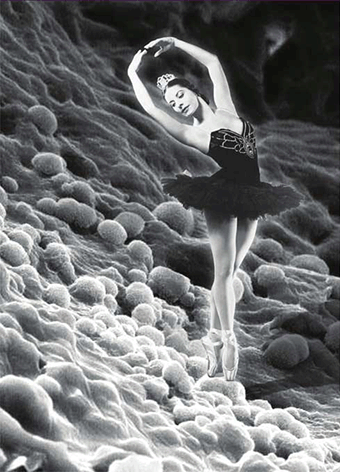Using photographic images captured by an electronic microscope, the exhibit – titled "Microworld Landscapes" – enabled visitors to see objects at the nanoscale (one nano equals one billionth of a metre). Molecules and atoms were made visible by the microscope's ability to enlarge images more than two million times their actual size. The images, which were projected as brightly illuminated crystals, revealed the atomic structure of materials and molecules.
 With the help of some of Cuba's most renowned artists, the crystalline pictures at the exhibit were not left to stand alone, but instead were wedded to images from the worlds of literature, art, dance and music − giving new meaning to the term "mixed media." The works of writer Roberto Fernández Retamar, film makers Lizette Vila and Roberto Chile, and ballerina Alicia Alonso were interpreted in a collection of alluring composite photographs in which crystalline landscapes framed the central portrait of the artist at work.
With the help of some of Cuba's most renowned artists, the crystalline pictures at the exhibit were not left to stand alone, but instead were wedded to images from the worlds of literature, art, dance and music − giving new meaning to the term "mixed media." The works of writer Roberto Fernández Retamar, film makers Lizette Vila and Roberto Chile, and ballerina Alicia Alonso were interpreted in a collection of alluring composite photographs in which crystalline landscapes framed the central portrait of the artist at work.
Augusto González García, a professor of theoretical physics at the Instituto de Cibernética, Matemática y Física (ICIMAF), conceived of the idea. Support for the exhibit came from the Cuban Physical Society and Havana University's Institute of Materials, ICIMAF and TWAS's national chapter in Cuba. More than 3,000 people visited the Habana Libre Hotel to view the photos during the two-week exhibition.
Hugo Pérez Rojas (TWAS Fellow 1994), professor of theoretical physics at ICIMAF, says that the exhibit proved noteworthy on two accounts. "First, the crystalline images allowed visitors to see something most had never seen before – the innermost structure of materials and molecules." No one would deny that these images are fascinating in their own right or that they provide new insights and information that are useful to scientists and technologists in a broad range of fields.
Second, Rojas observes that "the exhibit placed these images in a variety of imaginative contexts that clearly delighted those who viewed the photos. Seeing a world-class ballerina pirouette on a dance floor comprised of magnified nano-sized animal cells is not something you're likely to forget anytime soon."
García notes that the exhibit took about six months to put together and required the cooperation of both his scientific colleagues and the artistic community. The microscopic images were taken by his fellow scientists, including Carlos Lariot, Mayra Hernández, Javier Martínez and María Dolores Durruthy. For them, the primary purpose of capturing these images was to help advance research in fields ranging from materials science to molecular biology. But, as García also notes, "his colleagues were delighted to use the images for another use, especially one that attracted such an enthusiastic public response."
"The most rewarding aspect of this initiative," García says, "was the delight you could see among those who visited the exhibit. The public's response showed that science and art have more in common that you might imagine. Both are united by creativity and both have the ability to elicit a sense of wonder, not only among those who engage in such endeavours but also among those who have an opportunity to see the products of their labour."
For additional information about the "Microworld Landscapes" exhibit, see www.juventudtecnica.cu/Juventud%20T/2011/fotorreportajes/paginas/universos.html (Spanish, with photos), or www.granma.cu/italiano/cultura/17-enero-micromondo.html (Italian).

